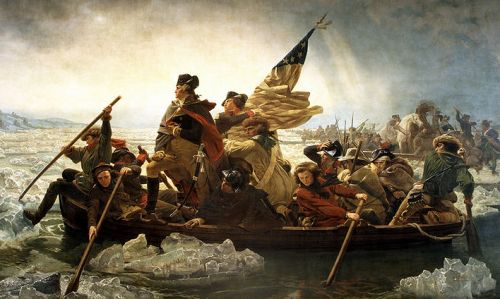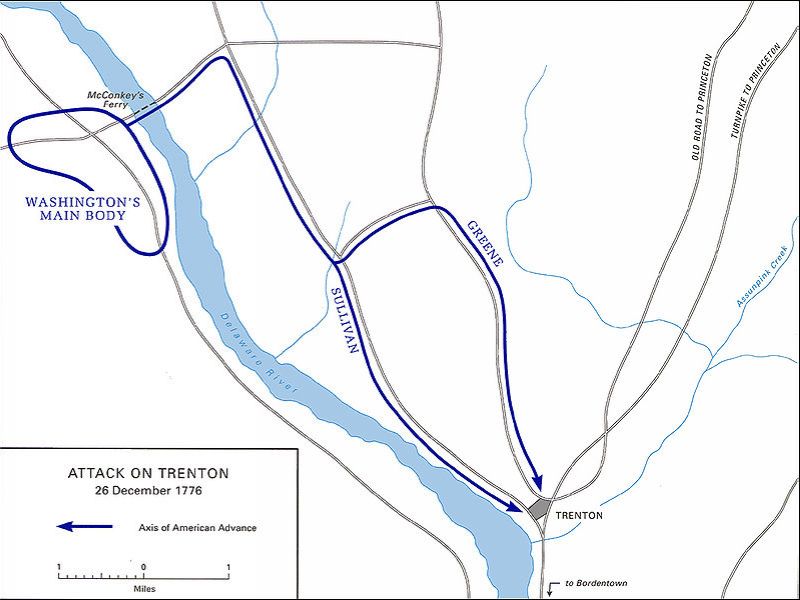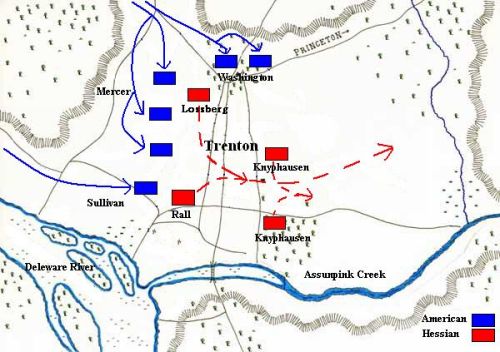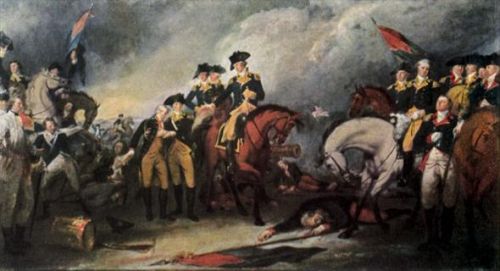The Battle of Trenton, New Jersey was one of the turning points of the American Revolutionary War. Having lost New York to the British at the Battle of Long Island in the summer, George Washington was desperate to turn things around.
After a long march through the snow, Washington led his troops across the partially frozen Delaware river on Christmas Day of 1776 to defeat the Hessian mercenaries and restore the fortunes of the American patriots.

George Washington crosses the Delaware River by Emanuel Leutze, 1851
The Story of the Battle of Trenton, New Jersey
Bloody footprints marked the ground where colonist soldiers had been walking in the white snow. Their aching feet did not have protection from the bitter cold, and now they were suffering the consequences.
The army had lost two men to the Delaware River, and they had wet almost all their gun powder. It had been hard keeping the supplies from washing down the river; it was even harder having to march in the snow and risk frostbitten limbs.
They were after the Hessian forces in Trenton, New Jersey. Their leaders, commander-in-chief George Washington, Major General Nathanael Greene, and Major General John Sullivan pushed them on with incredible courage.
The Battle of New York
Encouraging their men was what these three knew to do and so they did it, hoping it would heal their downhearted spirits from the previous attempt to drive out the British. Washington had been with the men earlier, when they had been forced out of New York by a British regiment. They had suffered defeat terribly, and the men were feeling disappointed.
Washington was determined, however, that they would have a victory and that they should take Trenton back for the last time.
The Delaware River
The only way to get to Trenton without being detected by the British was by boat down the Delaware River. He had not chosen the best time of year to do this. Winter had begun, and crossing the Delaware was a risky venture.
The river itself already had ice floes forming on its surface. Washington needed extreme courage to overcome the heavy spirit of the men, the forces of nature, and discovery by the British.
The plan was to cross the Delaware at three points: one with a Rhode Island regiment accompanied by Pennsylvania and Delaware troops, a second under Brig. Gen. Ewing, and a third led by Washington himself along with Major Generals Nathanael Greene and John Sullivan.

Map of the Battle of Trenton
Preparations for the Battle of Trenton
One of Washington’s staff officers in the Battle of Trenton theorized that the Hessian soldiers would celebrate their traditional German festivities and be drunk. However, evidence suggests that they were sober, but extremely tired.
There are other reports about why the commander of the Hessians, Colonel Rall (sometimes spelled Rahl)—a German and ally to King George III—seemed unprepared for the assault.
These include:
- That Colonel Rall had been given a warning by a loyalist previous to Washington’s arrival but failed to read it.
- That a colonist, posing as an escaped allied prisoner of Washington, led him to believe the Colonial forces to be dispirited and unmotivated.
- That a prior attack by a local militia had been repelled, possibly leading to the assumption that the engagement had ended at that point.
Whatever the reason, Col. Rall was apparently resting when the Americans showed up to engage him in battle. However, he had written to British officials to ask for reinforcements should the attack from the colonists really come. The British refused to send troops. This happened twice.
Left without the needed help, Rall determined with two other commanders to spread out their forces so they could cover each other’s flanks.
The March to Trenton
Nature wasn’t especially advantageous for the Americans on the way to the Battle of Trenton. The difficulties posed by the snow and cold weather dampened not only the men’s spirits, but reduced the chance of being able to take Trenton.
“Discipline is the soul of an army. It makes small numbers formidable; procures success to the weak, and esteem to all.”
– George Washington
When General Sullivan wrote to Washington about the gunpowder getting wet, Washington replied firmly, “Tell General Sullivan to use the bayonet. I am resolved to take Trenton.”
Washington kept riding down the lines of soldiers encouraging his men that they could take Trenton and still make it back to their families alive.
What they didn’t know was that another force of American soldiers led by Adam Stephen would join them halfway in their march to the Battle of Trenton. When they did meet the other men they were frightened at first. Upon discovering that they were Americans, the colonists began to have confidence that this feat could be accomplished.
Washington rode in front of his men as they marched down Pennington Road, about one mile northwest of Trenton. He sent out an advance of troops to a Hessian outpost in a copper shop on Pennington Road.
The Battle of Trenton, New Jersey
The battle began when a German, Lieutenant Andreas von Wiederholdt, came out of the copper shop to get fresh air and was shot at by the American troops. Some of his men ran from the shop and surrounding area when Lt. Wiederholdt started yelling, “Der Feind!” (The enemy!)
The small contingent was no match for the American troops, and they hurriedly organized a retreat.
Washington knew that he needed to cut off all means of retreat for the Hessians. He ordered some of his men to disband and assemble near Princeton. General Sullivan stationed his men near Assunpink Creek.

Detailed map of the Battle of Trenton
Some Prussians, Lt. von Grothausen and his Jägers [hunters], started to shoot at the Americans assembling near the creek, but they did not see all the troops that were advancing. Once they did, they beat a hasty retreat as well.
Some of the German soldiers tried to swim across the creek while others fled across the bridge, which had not yet been taken by the colonist forces.
Greene and Sullivan joined their troops together in hopes of containing the Hessians in one area.
Other Hessian forces had heard the first shots being fired at the Americans and began to regroup along the major streets in Trenton to overpower them. They were professional soldiers, and the Americans mere farmers who had already lost New York.
When the Americans boldly met them head on, the Hessians realized they had miscalculated and began withdrawing their troops. They tried to flank Washington’s men north of the town.
While Col. Rall and his men concentrated on Washington’s men, Sullivan and Greene split up their militia once more to block off escape routes from Trenton. Other colonist soldiers hid in the buildings and homes of civilians, hoping to be able to snatch any unfortunate Hessians who tried to escape.
Rall had now turned his attention elsewhere and, seeing that the colonists had taken control over their cannon, tried to fight to get it back. He was successful but to no avail. When they tried to turn four guns on the Americans, they found that the guns themselves would not fire at all.
Forced once again to flee, they made for an orchard near the creek Gen. Sullivan and his men had been guarding. The Hessians were no match for the Americans this time.
Sullivan’s troops began firing, and Rall was mortally wounded in the process. When their colonel was shot, the Hessian troops began to scatter in all directions. When Sullivan was joined by Washington not much later, the Hessians surrendered.

Hessians surrender at the Battle of Trenton as portrayed by John Trumbull
Rall, the commander of the Hessians in Trenton, died later that day.
While the American generals handled the surrender, other Hessian forces tried to sneak their way out of town with a cannon. When they were stuck in the muddy roads with only a few men, Gen. Sullivan found them and made them surrender.
Aftermath of the Battle of Trenton
The victory of the Battle of Trenton encouraged the Americans to push ahead in the fight for independence. Even though this was a great victory for them, they could not yet move on. They were forced to withdraw because of the many prisoners they held captive, to strengthen their troops for future battles, and because they did not have any provisions to with which to journey.
The important thing was that they made it home with boosted spirits, now knowing that independence was not impossible when people worked together as one.


